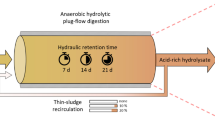Abstract
The kinetics of dilute-acid pretreatment/hydrolysis of the hemicellulose in a mixture of corn cobs and corn stover was investigated. The kinetic data confirmed that the hemicellulose in this feedstock is of a biphasic nature. The kinetic model recognizes the presence of soluble xylose oligomers, xylose monomer, and the decomposition of xylose. The kinetic parameters were determined over the conditions of 120–150°C, and sulfuric acid concentration of 0.44–1.90%.
The biphasic nature of the kinetics brings about an additional flexibility in the reactor design and the operation strategy, since different reaction conditions can be applied to each of the two different fractions of hemicellulose in the feedstock. With incorporation of the kinetic data, a percolation reactor operated under various modes, uniform temperature, temperature step change (along with or without flow rate step change), and two-stage reverse-flow operation, was modeled and investigated for its performance. The modeling results affirmed that a step-change/reverse-flow operation is advantageous for biphasic substrates, including agricultural residues. The optimum temperature difference in the stepchange operation was determined to be 30°C over a wide range of reaction temperature. Temperature step change alone (without use of reverse-flow mode) increased the product yield by 3–11% (depending on the reaction conditions) over that of uniform temperature operation. The most significant improvement, however, was seen with application of a two-stage reverse-flow reactor arrangement with temperature step change employing different conditions at each stage. This operation essentially doubled the sugar concentration over that of the temperature step change operation.
Similar content being viewed by others
Abbreviations
- A:
-
acid concentration
- C0′ :
-
initial xylan concentration in percolation
- Ei :
-
activation energy fork i
- F1,F2:
-
fast and slow fraction of hemicellulose
- H:
-
hemicellulose concentration
- koi :
-
frequency factor fork i
- ki :
-
rate constant = Ani,koiexp(Ei/RT), min−1
- L:
-
reactor length, cm
- ni :
-
acid concentration exponent
- O:
-
oligomer concentration
- R:
-
universal gas constant
- S:
-
dimensionless concentration
- t:
-
time, min
- T:
-
absolute temperature, °K
- u:
-
velocity inside percolation reactor
- x:
-
distance coordinate along reactor length, cm
- X:
-
xylose concentration
- Y:
-
yield
- z:
-
x/L
- αi′ :
-
κ3/κi, I = 1,2
- βi :
-
κiL/u
- γi :
-
κ4/κi′, I = 1,2
- ρ:
-
τ1/ τ
- τ:
-
tu/L
- τ1, τ2 :
-
dimensionless time before and after temperature shifting in step-change mode
- ω:
-
ratio of velocity at high temperature to low temperature
- 0:
-
value att = 0
- 1:
-
fast-hydrolyzing hemicellulose
- 2:
-
slow-hydrolyzing hemicellulose
- O:
-
oligomer
- T:
-
total
- X:
-
xylose
References
Lee, Y. Y., Lin, C. M., Johnson, T., and Chambers, R. P. (1978),Biotechnol. Bioeng. Symp. 8, 75–88.
Limbaugh, M. L. (1980), MS Thesis, Auburn University, AL.
Cahela, D. R., Lee, Y. Y., and Chambers, R. P. (1983),Biotechnol. Bioeng. 25, 3–17.
Kim, B. J., Lee, Y. Y., and Torget, R. (1993),Appl. Biochem. Biotechnol. 39, 119–129.
Kim, S. B. and Lee, Y. Y. (1987),Biotechnol. Bioeng. Symp. 17, 71–84.
Kim, B. J., Lee, Y. Y., and Torget, R. (1994),Appl. Biochem. Biotechnol. 45, 113–129.
Torget, R. W., Hsu, T.-A., Kadam, K., and Phillippidis, G. P., and Wyman, C. E. (1993), Prehydrolysis of Lignocellulosic Materials, US Patent applied for.
Lee, Y. Y., Kim, B. J., and Chen, R. (1993), Final Report for Subcontract-NREL-XD-1-11121-1.
FORTRAN Subroutines for Mathematical Applications, User’s Manual, IMSL, Inc., Houston, TX, (1991), p. 1096–1102.
Freund, R. and Littell, R. (1992),SAS System for Regression, 2nd ed., SAS Institute Inc., Cary, NC, p. 169–188.
Torget, R. W., Hayward, T. K., Hatzis, C., and Philippidis, G. P. (1995), presented at the 17th Symposium on Biotechnology for Fuels and Chemicals, Vail, CO.
Author information
Authors and Affiliations
Rights and permissions
About this article
Cite this article
Chen, R., Lee, Y.Y. & Torget, R. Kinetic and modeling investigation on two-stage reverse-flow reactor as applied to dilute-acid pretreatment of agricultural residues. Appl Biochem Biotechnol 57, 133–146 (1996). https://doi.org/10.1007/BF02941694
Issue Date:
DOI: https://doi.org/10.1007/BF02941694




